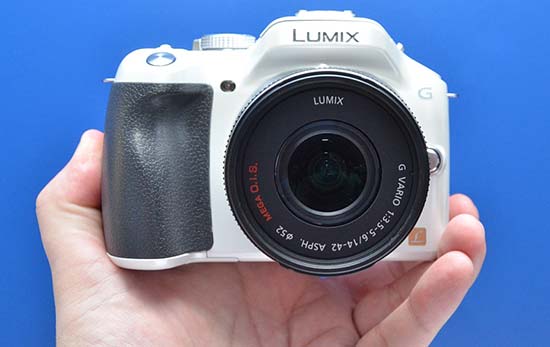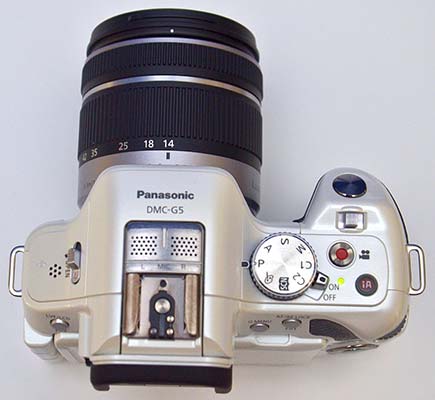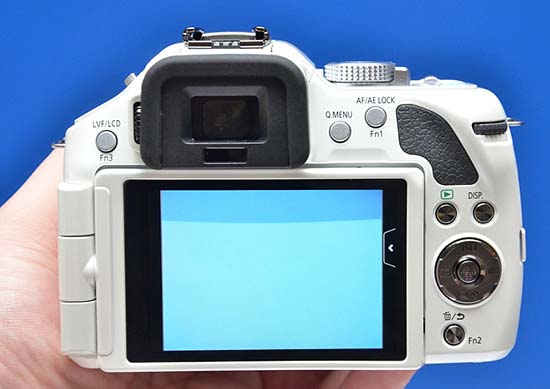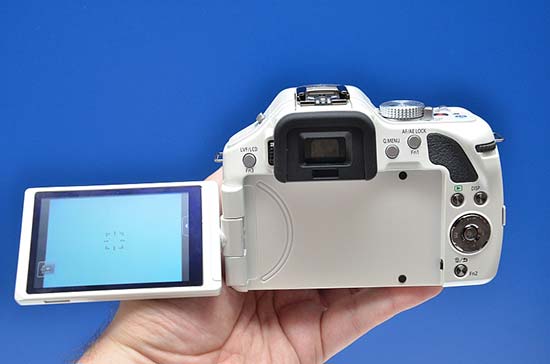Panasonic Lumix G5 Hands-On Preview

A hands-on preview of the new Panasonic G5 compact system camera.
Billed by its manufacturer as „a truly revolutionary digital single lens mirrorless camera," the Panasonic Lumix G5 is successor to the highly successful and critically acclaimed G3, which was one of the few cameras to have earned our highest "Essential" rating when we reviewed it back in May 2011. Earlier this month, we had an opportunity to try out a pre-production Panasonic G5 at a press event held in Budapest, Hungary. The following is a brief summary of our initial impressions.

The first thing you’ll notice about the Panasonic Lumix G5 is the redesigned hand-grip, which is quite a bit chunkier than the one on the G3. This has allowed the designers to place the shutter release on the top of the grip, similarly to the G2. It’s also worth noting that the button is now angled forward in a more comfortable position, a small but thoughtful improvement over earlier designs. Right behind the shutter release is an all-new Function Lever, which allows users to control power zoom lenses in a similar vein as with a compact camera. While this functionality is quite clearly aimed at first-time CSC users trading up from point-and-shoots, the lever can be reprogrammed to control one of the exposure variables - something that more experienced users will surely appreciate.

The rear controls have been reshuffled once again. The movie record button has been relocated to the top of the camera, not far from where it was on the G2, with a reprogrammable AF/AE Lock button taking its place. The quick menu is now accessible via a dedicated, non-customisable button located to the left of the AF/AE Lock, while the Fn2/Delete/Back button has remained underneath the four-way controller. The Playback button has moved to a position next to the Display button. A brand new, rubberised thumb rest enables users to hold the camera more comfortably, while the thumb-operated control dial has moved further to the right, making it easier to locate while holding the camera up to your eye. As on the G2 and G3, this control wheel can be pushed inwards, and is used to affect changes to the main exposure variables as well as exposure compensation.

The Panasonic G5 sees the return of the very useful eye proximity sensor, which was one of the things we liked about the G2 and missed from the G3. This allows automatic switching between the rear screen and the electronic viewfinder. The feature can be disabled from the menu if you find that it interferes with the way you like to shoot (e.g. if you use the camera for waist-level shooting, with the LCD folded out). The physical LVF/LCD toggle has been retained but it’s now reprogrammable to perform a different task. The LCD screen itself is similarly sized to the one found on the G3 but offers twice the pixel count for a sharper image. The specifications of the EVF (1,440,000 dots, 1.4x magnification, 17.5mm eyepoint) are unchanged from the previous models.
Some of the biggest improvements are found under the hood. As far as we’re concerned, one of the most useful novelties is the option to use a completely silent electronic shutter for taking full-resolution stills. This feature will likely be appreciated by street photographers as well as anyone who needs to work in total discretion. Having actually used the camera, we can confirm that the electronic shutter is indeed entirely silent. That said, the Panasonic G5 still has a mechanical focal-plane shutter capable of shutter speeds ranging from 1/4000th to 60 seconds and a flash sync speed of 1/160th second.

The Lumix G5 also offers a few improvements in terms of its AF performance. Firstly, it has a so-called Eye Sensor AF feature, meaning AF is automatically activated when you look into the viewfinder. This is likely to be something you either love or hate - if you find yourself in the second camp, the good news is that you can turn it off from the menu. Secondly, you can now select and modify the position of the AF frame by touch even when using the eye-level viewfinder. With this feature enabled, the LCD screen turns into a touch pad, much like the one on your laptop. Thanks to the gesture support of the Panasonic G5’s touch-sensitive screen you can move the AF target anywhere within the frame with your finger and monitor the changes in the viewfinder. This may require a bit of getting used to but it’s probably the fastest way of repositioning the active AF point with the camera up to your eye. Panasonic also claims extremely high focusing speeds with this camera, and we have indeed found the AF system to be very fast and accurate - as long as you’re shooting stationary subjects. Switching to continuous auto-focus and Continuous Low burst mode, and shooting subjects moving toward the camera, we have found that the G5 would often focus on the background instead of the subject - but given the relatively short time we spent with the camera, this may well have been caused by user error. This is definitely something we would like to explore in depth when we receive a production unit for review.
Other notable novelties include a continuous shooting mode of up to 6fps at full resolution, in-camera HDR exposure blending, a dual-axis level gauge and a number of new digital filter effects.
On the video front, the Panasonic Lumix G5 now offers 1080p movie recording in both AVCHD Progressive and MP4 format (the G3 had 1080i). As with its predecessor, the fold-out LCD screen and full-time continuous auto-focus make it a lot better suited to casual videography than most DSLRs. The tap-to-focus feature is also available with movies, making it easy to shift focus from one subject to the other while filming. Creative filters can be applied to videos as well as stills, which can potentially save you a lot of time at the post-production stage.

Overall, the Panasonic G5 has been a joy to use - while not necessarily the revolutionary product that it’s claimed to be, it surely is a small, fast and responsive little camera that is extensively customisable and extremely versatile. Putting aside a few specialised areas, it’s hard to imagine a photographic task that you can’t perform with it.
Click Here for our Panasonic Lumix G5 Sample Images
Update: Our full Panasonic Lumix G5 review is now available online.
Image Gallery
Click on a thumbnail to see the full version.

Loading comments…